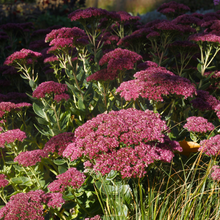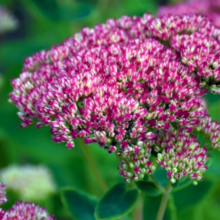Sedum 'Herbstfreude', commonly known as 'Autumn Joy' sedum, is a popular succulent perennial valued for its robust growth and late-season flowers. This Sedum cultivar features fleshy, grey-green leaves and produces clusters of pink flowers that gradually deepen to a rich, rusty red in autumn. Its upright growth and ability to attract pollinators make it a valuable addition to gardens, borders, and rockeries, adding a touch of autumnal colour and texture to various settings. It belongs to the Crassulaceae family.
Origin: 'Herbstfreude' is a cultivated Sedum hybrid.
Light: Sedum 'Herbstfreude' thrives in full sun. It requires at least 6 hours of direct sunlight per day for optimal growth and flowering.
Water: Water sparingly, especially once established. Allow the soil to dry out thoroughly between waterings. Overwatering can lead to root rot.
Soil: Sedum 'Herbstfreude' prefers well-drained soil. It can tolerate a range of soil types, including poor, sandy, and rocky soils. Avoid heavy clay soils, which can retain too much moisture.
Fertilising: Sedum 'Herbstfreude' generally does not require heavy fertilisation. A light application of balanced fertiliser in spring can help promote healthy growth. Avoid over-fertilising, as this can lead to excessive foliage growth at the expense of flowers.
Pruning: Cut back the plant in late autumn or early spring to tidy it up and encourage new growth. Deadheading spent flowers can prolong the blooming period.
Division: Divide the clumps every 3-4 years in spring or autumn to rejuvenate the plants and prevent overcrowding.
Pests and Diseases: Sedum 'Herbstfreude' is generally pest and disease resistant, but keep an eye out for slugs, snails, and aphids.
Uses: Sedum 'Herbstfreude' is primarily grown as an ornamental plant for its attractive flowers and late-season colour. It's a popular choice for gardens, borders, rockeries, and green roofs. It also attracts pollinators like bees and butterflies.
Toxicity: Sedum 'Herbstfreude' is generally considered non-toxic to humans and pets



